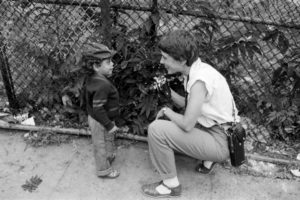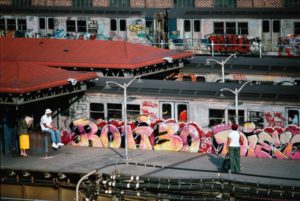Martha Cooper, Legendary Chronicler of Graffiti (Thailand)
Thanks for the ‘heads up’ from Marnie Mueller (Ecuador 1963-65)
A Touching Portrait of Martha Cooper, a Legendary Chronicler of Graffiti
Martha: A Picture Story, is the first documentary that focuses on the life and career of one of the most important urban photographers of the past half-century.
by Christopher Lee Inoa
May 1, 2019
Martha Cooper with young child in the 1970s (photo by Dan Brinzac)
Martha Cooper didn’t set out to become a legend when she started taking photos of the graffiti-covered subways cars that made their way from the Bronx to the rest of New York City in the 1970’s and 80’s. She definitely didn’t think she would be considered an icon when she and fellow photographer Henry Chalfant presented what would become Subway Art to publishers in NYC. After many rejections, and later poor sales when it finally did get published, Cooper then thought that part of her life was over.
It wasn’t until touring Germany in 2004, in promotion of her third book, The Hip-Hop Files, that Cooper realized for the first time the impact Subway Art had had on readers. To aspiring artists around the world, this book had become like a sacred text; Cooper’s photography was instrumental in inspiring them to pick up spray cans and markers and begin writing on walls and train cars. Subway Art helped expand graffiti beyond the train yards of NYC to become a global art form. An initial failure, it has become her most defining work, one that has been republished numerous times and has now sold over one million copies.
Subway Art by Martha Cooper and Henry Chalfant (1984)
The story of Subway Art is enough for its own film; however, what Australian director Selina Miles decided to do for her first feature-length documentary is instead tell a more illuminating portrait of the woman who helped expand graffiti culture to the world.
Martha, A Picture Story, which made its world premiere at the Tribeca Film Festival several days ago, is the first documentary that focuses on the life and career of one of the most important urban photographers of the past half-century. Given her first camera at the age of three by her father, who ran a camera shop in Baltimore along with her uncle, Cooper has dedicated her life to capturing people rising above their surroundings and to discovering small pockets of culture hidden in plain sight.
A touching portrait, Martha succeeds on two fronts: as an introduction to those who are completely unaware of what this woman’s work has meant to graffiti artists and admirers worldwide, and as an opportunity for these same artists and admirers to realize that she has done more than that.
Martha Cooper in her studio (2018) from Martha: A Picture Story
In Martha, you learn that years before she entered her first train tunnel, Cooper was a member of the Peace Corps, riding a motorcycle through Southeast Asia. She was the first female photography intern for National Geographic, and the first female staff photographer for the New York Post — the job the lead her to discovering the thriving graffiti culture of NYC. And that’s just in the first 30 minutes of this 90-minute documentary.
Miles is a self-taught filmmaker who has directed a number of short documentaries and a miniseries on street art over the past decade. She uses old television and documentary footage, personal photos and home movies, sit-down interviews with Cooper and some of the many people she has come across in her 50-plus years in photography, as well as just a handful of the countless photos she has taken throughout her career, to tell Cooper’s journey. Some of these interviews work better than others, especially the one with Cooper’s cousin, Sally Levin: Like Cooper, she just radiates positivity, and has the best anecdotes about her cousin.
The biggest highlight is, of course, Cooper’s work on screen — and I’m not just referring to the graffiti and Hip Hop photos, which are as vibrant and impactful today as they were decades ago. I’m talking about the series on Casitas, small homes built in the vacant lots of Puerto Rican communities; the series on her childhood neighborhood, which was done in tribute to her parents; the series of her time in Sowebo, a poor community in South West Baltimore that has been gentrifying in recent years after decades of urban decay; and her Japanese tattoos photos, her discovery of a subculture that was largely ignored by American magazines.
Martha Cooper in her studio (2018) from Martha: A Picture Story
Now in her mid-70s, Cooper is still taking pictures. There’s a sequence in the film where Cooper follows the anonymous German graffiti crew 1UP into a Berlin U-Bahn station where the masked men spray paint the walls of the station via a fire extinguisher. There are random people there, jaws open, and there’s also Cooper, smiling as she snaps away, not letting old age keep her from doing what she loves.
Martha: A Picture Story, screened as part of the 2019 Tribeca Film Festival’s This Used to Be New York section with its final showing at the Village East Cinema (181-189 2nd Ave,East Village, Manhattan).




Good morning, John.
Do you know the name of the Baltimore camera shop mentioned in the article? I grew up and worked in Baltimore and am curious about the shop.
And as long as I’m writing, I want to thank you once again for the work you do to keep our Peace Corps family alive in the hearts and minds of so many.
Sorry, Allan, I don’t know the shop…I’ll see if I can find out.
Thanks for you nice words about Marian Beil and my website.